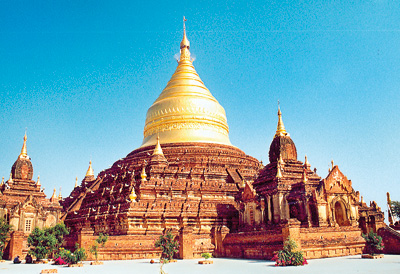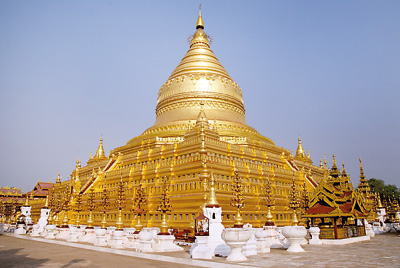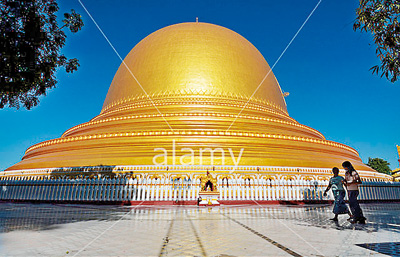Myanmar and its many connections to the Sacred Tooth Relic of Kandy
Not only in Sri Lanka, the worship of the Sacred Tooth Relic of the Buddha in Kandy is considered an unparalleled religious act among the Buddhists in Southeast Asian countries such as Myanmar, Thailand, Cambodia and Laos. All Myanmar kings wished to obtain a replica of the Tooth Relic; some even wanting the genuine Tooth Relic, to gain legitimacy for their rule. Several did obtain a replica, and enshrined it in a stupa; in fact, the oldest such [Tooth Relic] stupas in Southeast Asia are in Myanmar. Two Myanmar kings who were great patrons of Buddhism, made every effort to possess the genuine Tooth Relic as they were building their empires.

Dhammayazika stupa
The Glass Palace Chronicle of Myanmar records that King Anawratha (Anuruddha 1044-1077 CE), the first historical king of Myanmar sent a mission to Sri Lanka along with a gift of a white elephant to obtain the Sacred Tooth Relic from his friend Vijayabahu I (1055-1110CE). When Anuruddha received the Tooth Relic (probably a replica), he placed it in a jewelled casket on a jewelled white elephant and set it free. The white elephant knelt at Shwezigon where a pagoda was built in 1059 and the relic was enshrined. Anuruddha then made a vow for another relic to emerge from the Tooth Relic. The second too appeared according to the Chronicle and he enshrined it in a stupa on Mt. Tangyi. In a similar fashion, a third too appeared and it was enshrined in another stupa which came to be known as Lokananda on the river bank of the old harbour where vessels from countries like Sri Lanka, Arakan (Rakhine) and the Mon Ramannadesa anchored. The fourth soon replicated was enshrined in a stupa on Mt. Tuywin and the fifth on Mt. Pyek. These stupas that exist up to now indicate that they were historical events although shrouded in the semi-mythical narration.
Sri Lanka Buddha relics enshrined in Dhammayazika Pagoda

Shwezigon stupa
A Myanmar inscription, now located within the Dhammayazika Pagoda records that, King Narapatisithu received four relics of the Buddha from the King of Thengu (Thengu being the name for Sri Lanka) who possessed thirty relics. On receipt of the relics, he was looking for an auspicious site to construct a pentagonal (five-sided) stupa to enshrine the four relics. While walking, the inscription says he spotted a column of vapour arising from the earth with the girth of a palmyra tree, and he marked the place with an iron nail. The king began the construction of the stupa on that spot, and it was completed within two years in 1198 CE. The king gifted 1,000 robes for monks and agricultural land throughout the country and made available the services of 500 Burmese and 500 Indian workers.
The inscription further mentions that the borders of Myanmar on the south as Selangor (Malaysia), and on the north as China, and that 1.5 million soldiers and 100,000 soldiers were employed for guarding the capital city of Bagan. Bagan was thus the centre of a major empire then, and it has been estimated that the population at that time of the Bagan empire to have been at least 4 to 5 million.

Thupayon stupa
The Dhammayazika Pagoda is among the largest stupas in Bagan with approximately six million bricks, based on estimates of the stupa’s volume. The five sides of the Pagoda are dedicated to the five principal Buddhas: the historical Buddha Gotama, his three predecessors, Kakusanda, Konagamana, Kasyapa, and the future Buddha Metteyya. Although this grouping of five Buddhas was considered important in Sri Lanka and other Theravada countries, only Myanmar built a five-sided monument to pay homage to this grouping. Among the Buddhist countries five-sided monuments are found only in Myanmar’s Bagan. There are sixteen such monuments in Bagan of which the majority is temples, not stupas.
King Bayinnaung’s desire to possess the Sacred Tooth Relic
King Bayinnaung, also known as Hanthawaddy Hsinbyushin (1551-1581 CE) of the Toungoo dynasty who united the whole of Myanmar was also a great patron of Buddhism. He constructed monasteries, repaired the Shwedagon pagoda and held mass ordinations at the Kalyani Sima. This sect was established in 1476 when Myanmar Bhikkhus received ordination on the Kalyani river in Sri Lanka. King Bayinnaung is specially known for the construction of the Mahaceti pagoda in Pegu (Bago) built to enshrine another alleged Tooth Relic from Sri Lanka. The dome of this pagoda is very similar to that of Sri Lankan stupas. He made several offerings to the Temple of the Tooth in Sri Lanka by providing for lights to burn in the shrine and had sent Myanmar craftsmen to beautify the building. He had even sent a broom made from his own hair and that of his chief queen for use in the Dalada Temple in Sri Lanka.
Being determined to possess the Tooth Relic with the intention of becoming the greatest monarch in the world, he even made an attempt to purchase a replica of the relic at a very high cost through the Portuguese who captured it in Jaffna. Both the King and the Portuguese believed it to be the authentic one. The Portuguese later burnt that replica in Goa. Thirteen years after that attempt failed, the King Bayinnaung sent envoys to Sri Lanka requesting for the real Tooth Relic and a princess in marriage.
As a wedding present, Don Juan Dharmapala of the Kotte kingdom, according to the Myanmar sources, sent a princess together with a tooth which he assured was the authentic relic. In 1576, according to the same Myanmar sources, the princess and the tooth arrived in Myanmar and were received with the highest honour. The tooth was deposited in a jewelled casket beneath the Mahaceti pagoda. The truth, however, was otherwise. The Tooth Relic never left the Temple of the Tooth and the King of the Kotte kingdom never had a daughter!
To enshrine a tooth-relic and an alms bowl obtained from Sri Lanka, Mahayazamanisula pagoda was built in Sagaing by King Thalun (1629-1648). This is a Sinhalese type pagoda with a similar dome, but with no square box over the dome. This is today one of the most venerated pagodas in Upper Burma. We should note that the Thupayon (a name derived from the Thuparama stupa in Anuradhapura) in Sagaing too has a Sinhalese type of dome.
This is only a brief sketch of places related to our Tooth Relic in Myanmar. Myanmar today is not visited by many Sri Lankans. By not visiting this friendly country, we are missing out part of our own heritage which lives on not only in the Tooth Relic related places, but in many other sites connected with Sri Lanka. We should all visit Myanmar where internal transport and accommodation is relatively cheap.


